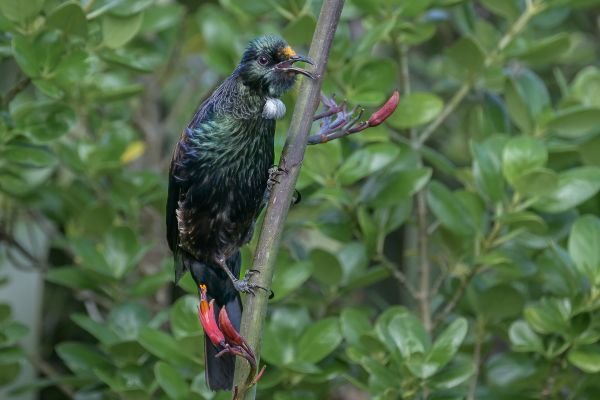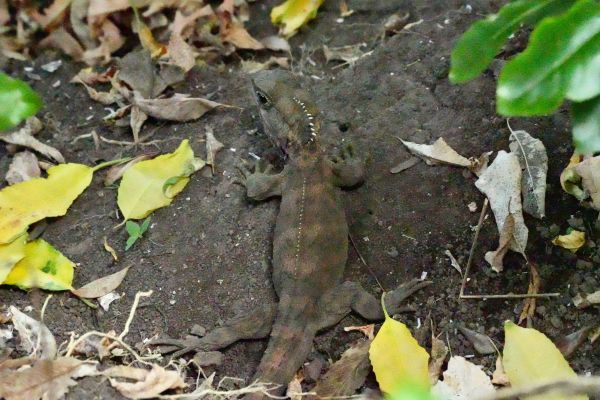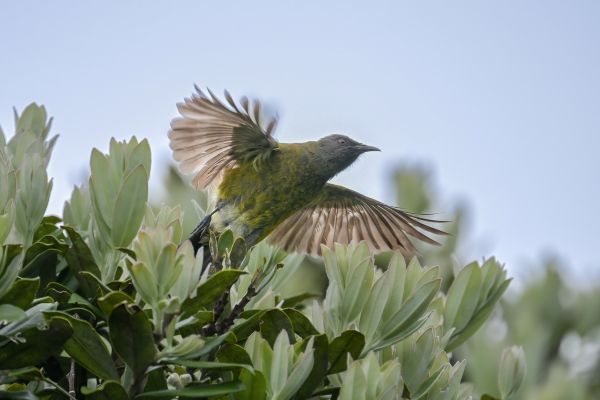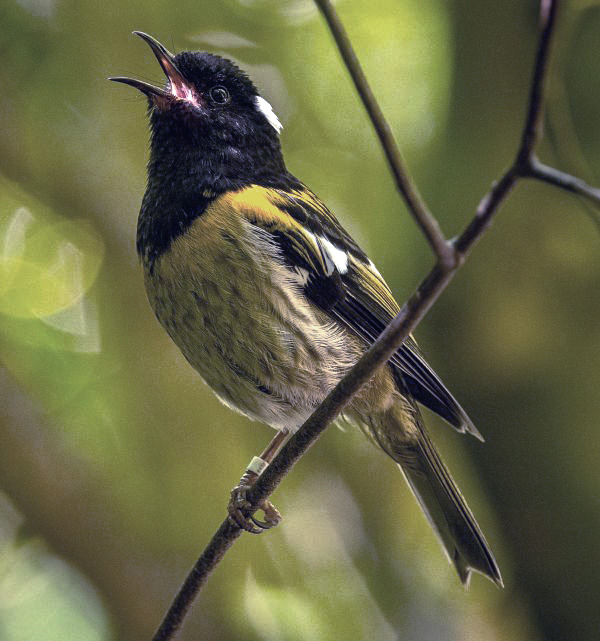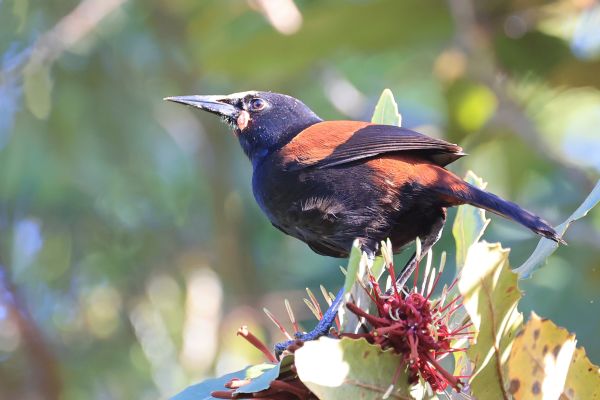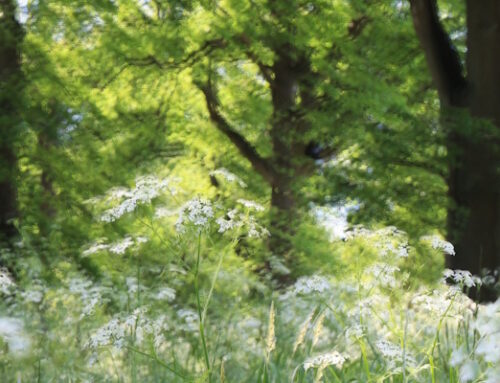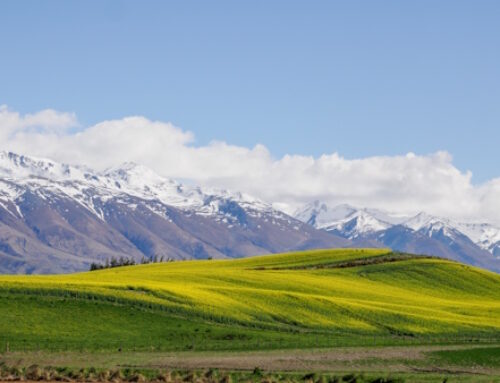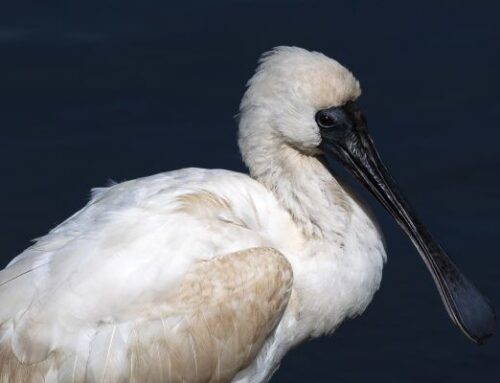Trip Leader: Linley Earnshaw
Day 1 – Sunday 2 Nov 2025 – Carolyn Elcock
When the ferry from Auckland arrived at the Gulf Harbour wharf at 9.25am, Sue and I were greeted by a very relieved looking Linley from onboard. The rest of our group had had to make their way across the Auckland marathon course closures to reach the wharf in the Auckland CBD, then the trip across the harbour to collect us. Once on Tiritiri Matangi wharf our bags were loaded on a trolley to be transferred to the trailer at the end of the wharf, for the trip to our bunkhouse at the base of the lighthouse. After checking out the brown teal ducklings in the pond, we made our first of many trips along the Wattle track. The birds seemed more numerous since my last visit to the island in 2019, saddlebacks, tui and bellbirds everywhere, even a takahe and chick behind the bunkhouse.
We managed to leave the bird distractions long enough to have our ranger’s briefing on rules, followed by sorting out of bunkrooms, loading food for the next 3-4 days into the fridges and lunch. Geoff Beale was on the island as a volunteer and offered to take us on a kokako hunt as he made his way down to the wharf. Success, not far along the Wattle track were a pair of kokako sitting sunning and feeding on the grass at the edge of path. It was the first of many sightings over the next few days.
Our first whiteheads were at the next water trough in a rewarewa tree. The rewarewa tree (Knightia excelsa), also known as the New Zealand honeysuckle, is not found in the South Island and has unusual red flowers. We were to find this tree was a favourite of the rifleman, hihi, tui and bellbirds. At the next water trough we found a young North Island robin begging for food from a parent with more tui and bellbirds. On the way to the next water trough the saddlebacks called warnings that sounded like their Māori name, tīeke, then hihi calling out in competition. Next was the wharf road where the flax was in flower, with kakariki and bellbirds being harassed by tui claiming ownership. Then it was back up to the bunkhouse via the Wharf Road with the calls of the long-tailed cuckoo overhead and brown quail having a dust bath on path. On the bunkhouse lawn, a pukeko family mowed the grass as the sun lowered in the sky at the end of our first day on the island.
Thank you to Linley for all the careful preparation and organization of a fabulous trip.
Day 2 – Monday 3 Nov 2025 – Richard Jones
I had a seriously early start (4.30am) leaving the bunkhouse on Day 2, as I was keen to be in the bush before the dawn chorus, both to hear the first bird songs and, in particular, to hear and record kōkako (using a small microphone plugged into my iPhone and recording via the WavePad app). The dawn chorus really got going about 5.45am and, while superb, was more subdued than I had expected.
I initially spent quite a bit of time recording the kōkako’s haunting song (it’s on the top of all bird songs for me) near the start of the track from the bunkhouse. I then sauntered along several tracks, in which I encountered and photographed tūī, korimako (bellbird), kererū (NZ pigeon), hihi (stitchbird), kākāriki (red crowned parakeet), pōpokotea (whitehead), Australian brown quail (cf. the extinct endemic NZ quail), pāteke (brown teal), tōrea pango (variable oystercatcher), and, quite unexpectedly, a mātātā (fernbird). Then back to the bunkhouse about 10.30am for a well-earned brunch.
On a walk later in the day, I caught up with Carolyn and Sue, we were all thrilled to see and photograph North Island kōkako and tīeke (North Island saddleback).
That evening, we did our own thing meal-wise, then chatted around the table, which included a debate on the merits and downsides of RAW over JPEG (this conversation has still to be completed, together with objective evidence).
What a wonderful day and what a wonderful four days on Tiritiri Matangi with 10 other fun members from NPSNZ. Considerable appreciation to Linley for initiating and organising this marvellous trip and experience on NZ’s top spot for endemic birds.
Day 3 – Tuesday 4 November – Barry Dench
Another day in paradise starting with the dawn chorus – what a sound to wake up to and a reminder of New Zealand / Aotearoa the way it used to be. With breakfast out of the way we set out to observe the birdlife amidst the bush cover and open areas but as the adverts say- there is more.
The wonder of us departing the bustle of our major city 2 days ago, riding in a modern ferry with a flat white etc. on offer, and now being within sight of the Sky Tower, observing and recording nature in abundance. So much going on, and the vista alone is worth being here for.
I got a little carried away with the shutter button and took over 2,000 photos today so dealing with these will be work in progress for a while. Today, of those photos there are lots of noisy images but a lot will be good record shots after applying Topaz Denoise and then there are my favourites for the day.
Tui may be commonplace on Tiirtiri but these birds have attitude and make great portraits, kakariki have an interesting feeding approach on flax and cabbage tree flowers, mature takahe with a chick roaming around outside the bunk house appeared to be unafraid in our presence and of the other stars – robins, stitchbirds, bellbirds, pigeons, the North Island kokako, fantails, whiteheads and quail were all photographed.
Sadly, this is our last night on the island but we need to make room for the next group booked in the bunk house.
My thanks to Linley for promoting and leading the trip and my fellow nature lovers for
your camaraderie.
Day 4 – Wednesday 5 November – Donna Jennings
I woke up early on Wednesday eager to fit in more exploring and photography around the logistics of packing up and returning to Auckland.
The weather was fine and sunny again and after a quick breakfast – headed out just after 6.30am, making the most of the softer light. It was good to get up on the ridge while the sun was low, then explore the lower tracks that would soon be filled with day visitors. Photographing the birds in the flax bushes early morning had become a daily routine for me on the island – tieke, tūi and korimako regularly feeding on the nectar. I particularly enjoyed the kākāriki messily dismantling the flowers and munching only on the best bits.
Even though there were only around 20 people on the island, I still met many group members along the tracks, the Wattle and Kawerau tracks being most popular with our group. I returned to the lodge at around 9am to finish packing and cleaning chores. The group was very efficient and only one chore remained – cleaning cupboards. Our bags needed to be out the front of the lodge by 10.30am in preparation for the next people staying.
It wasn’t long before our peaceful quiet island filled with the sound of tourists and school children and I chose to go along the quieter link tracks. The group gathered again around lunchtime at the lodge to load our bags onto the ute and trailer – a little lighter without all the food we ate. Our final journey down the hill to the ferry – we were rewarded with a pair of hīhī, and a pair of kokako, bidding us farewell. A fabulous three days on the island – a wonderful mixture of solo and group adventures.
Thanks to Linley for organising.
